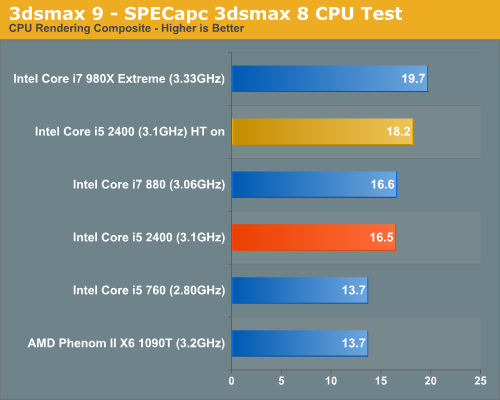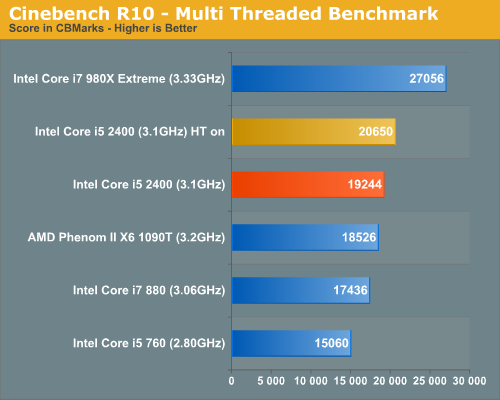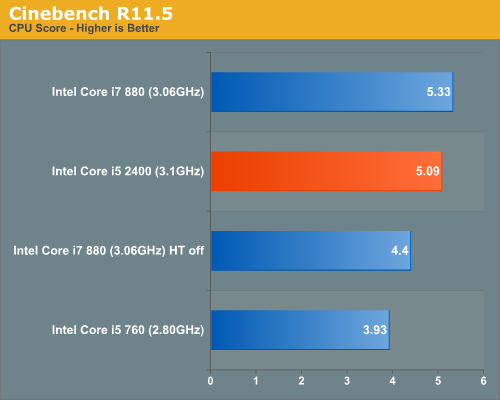The Sandy Bridge Preview
by Anand Lal Shimpi on August 27, 2010 2:38 PM EST3dsmax 9 - SPECapc 3dsmax CPU Rendering Test
Today's desktop processors are more than fast enough to do professional level 3D rendering at home. To look at performance under 3dsmax we ran the SPECapc 3dsmax 8 benchmark (only the CPU rendering tests) under 3dsmax 9 SP1. The results reported are the rendering composite scores:

This is another one of those situations where the Core i5 2400 without Hyper Threading is able to perform on par with the Core i7 880 with Hyper Threading. Compared to the i5 760 it’s 20.5% faster.
With Hyper Threading enabled, the Core i5 2400 is actually dangerously close to the 6-core 980X. Whatever Intel has done to Sandy Bridge's FP is big.
Cinebench R10
Created by the Cinema 4D folks we have Cinebench, a popular 3D rendering benchmark that gives us both single and multi-threaded 3D rendering results.

Cinebench was particularly surprising because it gives us a good opportunity to look at single threaded FP performance. Compared to a similarly clocked Lynnfield, Sandy Bridge can deliver 11% better performance. Compared to a similarly positioned Lynnfield, Sandy Bridge is about 20% faster. Note that this is without turbo enabled. The retail 3.1GHz chip should turbo up to 3.4GHz in this test, giving it a 9.6% frequency boost.
In the multithreaded test Sandy Bridge’s per-core performance is even better than Lynnfield with HT enabled.

I also ran a few numbers using Cinebench R11.5. I didn’t have the opportunity to test the i5 2400 with HT enabled in this test so I measured performance of the i7 880 with HT enabled/disabled to compare per-thread performance.

Sandy Bridge's FP performance is very good. Clock for clock we see a 15.6% improvement over Lynnfield (4C/4T vs. 4C/4T). Compared to the proposed similarly priced Core i5 760, the i5 2400 would be 29.5% faster.
POV-Ray 3.73 beta 23 Ray Tracing Performance
POV-Ray is a popular, open-source raytracing application that also doubles as a great tool to measure CPU floating point performance.
I ran the SMP benchmark in beta 23 of POV-Ray 3.73. The numbers reported are the final score in pixels per second.

The similarly positioned/priced Core i5 760 is beat by 17%. There’s no replacement for more cores/threads however as the i7 880 and X6 parts both pull ahead. Turn on HT to level the playfield (at least within Intel) and Sandy Bridge is 15% faster than Lynnfield.










200 Comments
View All Comments
Anand Lal Shimpi - Friday, August 27, 2010 - link
We'll have to wait a little bit to find out... :)hnzw rui - Friday, August 27, 2010 - link
If it doubles Clarkdale's GPU performance, then it probably will (at least on lower resolutions). I'm getting pretty decent framerates from Clarkdale on 1360x768 Low and I've been able to play on 1360x768 Medium with a Radeon HD 4550. I think Sandy Bridge is probably closer to the latter than the former in performance.SteelCity1981 - Friday, August 27, 2010 - link
Any word when Intel will launch a mobile version of this new platform?Anand Lal Shimpi - Friday, August 27, 2010 - link
Q1 2011 :)BSMonitor - Friday, August 27, 2010 - link
So glad I waited on a 13" macbook pro! Sandy Bridge will probably be the next revision for Macbook's ehh?cheinonen - Friday, August 27, 2010 - link
Exactly my thoughts, that the GPU performance looks to be good enough that Apple could use it for the 13" MBP refresh next year. I'll be glad that I decided to wait, that's fur sure.synergist - Friday, August 27, 2010 - link
I was doing some research and if they would have to use the full integrated graphics core, with the 12 cores, to top the performance of the 320M in the current macbook pro 13 I doubt apple would take a step backwards in gfx performance, and use the 6 core integrated gfx.and the performance would still be pretty close, that the 320M would lose to the inter grated gfx (12 cores) by about 10-13%
and llano is still an option, but I have a feeling it will be a dead heat with this.
starfalcon - Friday, August 27, 2010 - link
Apple has to know a lot of the people buying the laptops are far from high end gamers.The amount of people with 320Ms who don't need them is probably a lot.
We'll see how all the different parts of Sandy Bridge work out.
Don't the Core iX processors not work with Nvidia Integrated graphics at all?
JarredWalton - Friday, August 27, 2010 - link
Correct on NVIDIA IGPs not working with Core 2010 (and presumably beyond). The need the QPI interface and Intel isn't licensing that to them.As for Apple, one thing to note is that they've started shipping all laptops with GPUs that support OpenCL it seems, so if Sandy Bridge doesn't have that they may do the same Optimus-style setup as current MBP. Not sure what they'd do with the base MacBook in that case, but Apple seems like they're gearing up to start leveraging OpenCL at some point in the near future. Pure speculation, though, so maybe SB's IGP will be enough, even if it's a step down from G320M.
DanNeely - Friday, August 27, 2010 - link
Aside from on the high end (LGA 1366/2011) the bus nVidia needs is DMI, not QPI. If I was nVidia I'd insist on getting rights to both because QPI is more futureproof. Specifically having more than a few high speed SATA6GB/USB3/etc devices will be able to saturate DMI since it's only the equivalent of a PCIe 4x slot (1.0 speed for 1156, 2.0 for 1155/2011) while QPI is a much higher capacity bus similar to AMD's HyperTransport.While intel seems determined to milk as much out of the (presumably) cheaper to implement DMI bus as it can; sooner or later they're going to either need to mainstream QPI or have the CPU die eat the SATA/USB3 controllers. I find the latter unlikely because it would require cramming even more data lines into the already overcrowded CPU socket area.